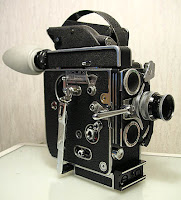 When I first designed this class I felt that it should contain a web video component so students would learn to communicate a message in a number of formats, including digital video. I therefore covered basic iMovie video editing skills in class, stressing the video editing techniques rather than how to execute them on a particular software package. I didn't want students to think they needed to have access to the same software package we used in class to create another digital video. I'm afraid some of them may have walked away with just that idea.
When I first designed this class I felt that it should contain a web video component so students would learn to communicate a message in a number of formats, including digital video. I therefore covered basic iMovie video editing skills in class, stressing the video editing techniques rather than how to execute them on a particular software package. I didn't want students to think they needed to have access to the same software package we used in class to create another digital video. I'm afraid some of them may have walked away with just that idea. To (hopefully) correct this misconception, I have decided to rely entirely on Web 2.0 video creation tools this semester. Students will each pick a tool from the list below and use it to complete their video project. We'll still cover basic video editing techniques in class, but students will have to figure out on their own how to apply that knowledge to the particular tool they picked. Here's what we will use:
Additional Resources:
- Flowgram - Mashup of web-based tools and voiceover narrative enables people to create a brand new type of webcasting multimedia experience.
- StoryMaker - A simple tool for creating digital stories. Using audio, pictures and text you can create storyboards, slideshows and much much more.
- Sprout - A quick and easy way for anyone to build, publish, and manage widgets, mini-sites, mashups, banners and more. Any size, any number of pages. Include video, audio, images and newsfeeds and choose from dozens of pre-built components and web services.
- TVNima - One of my favorites! An online machinima application that lets you create TV shows with your own images, videos, music, voice, sound effects etc.
- RemixAmerica - Allows users to create remixes by uploading their own video footage and sound clips to the site, searching YouTube for footage, or using video clips already uploaded to Remix America. Wired story on the RemixAmerica.
- VIDDIX - A new video platform that allows users to add all kinds of webcontent to their video timeline.
- muveeMix - Allows users to create their own short personal videos from raw footage, music and pictures. The result, called a muvee, can then be embedded in your blog or shared with your friends via email. The service comes free of charge (for limited accounts), though registration is required.
- Animoto - web application for making videos. Matches the video to your pics & music.
- JayCut - Create your own movies and slideshows, so called mixes.
- Brightcove Storymaker - Produce and publish professional slideshows, podcasts, and custom rich media
Additional Resources:
- CurrentTV assignments - List of all the news & commercial assignments on CurrentTV
- FixMyMovie - If the quality of your video footage is low, run it through this first. Automatically cleans your movies with MotionDSP's advanced video technology.
- Public Domain Pictures - Repository for public domain pictures
- Wikimedia Commons - A media file repository making available public domain and freely-licensed educational media content (images, sound and video clips) to all
- Resources previously listed on the course blog

2 comments:
Hi,
You have a cool blog here. Thanks a lot for sharing this useful information.
Commercial software is most often proprietary software, but free software is also used as commercial software. All or parts of software packages and services that support commerce are increasingly made available as free software, including products from Red Hat, Apple Computer, Sun Microsystems, and Google.
There are numerous advantages of commercial software in your home based business. This is especially true if you experiment with trial ware, demo ware, and even shareware. When you own and operate a home based business, every single minute counts. It is important to find resources that can assist you in time management, preserving energy, and increasing your overall productivity and efficiency.
Free Software Directory
Stewart - thanks for the clarification between commercial & proprietary software and for the link to the free software directory.
Post a Comment